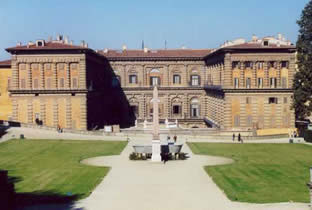Firenze - Pitti Palace

The architectonic project of Pitti Palace, ordered by the merchant Luca Pitti and started around 1457 AC, event though it is attributed by some researchers to Leon Battista Alberti, for the main part of the art critics this monument is the work of Filippo Brunelleschi.
The direction of the works of this monument, works which were interrupted in 1465 AC when the Pitti family declined, has been cured by Eleonora di Toledo, wife of Cosimo I who charged the architect Bartolomeo Ammannati to realise the works.
It is during this period that it is added to the three floors palace, faced with ashlar-work and possessing large opened and arched windows, also an important courtyard.
The famous "passageway vasariano" that goes across Ponte Vecchio unifying Palazzo Pitti with the Offices, on the opposite shore of the Arno River, was realised in 1565 AC at the same time as the beginning of the works for the arrangement of the "gardens of Boboli". The internal decorations, realised during the 17th and 18th centuries in a splendid baroque style were mainly the work of Pietro da Cortona.
With the death of Gian Gastone de'Medici in 1737, the sister Anna Maria Luisa obtained that the entire art collection of the Medici remained the property of the city of Florence, throwing the basis for the conversion of Palazzo Pitti and of the Offices in museum.
The other two lateral sides, inserted between 1764 and 1783, such as the most antique Renaissance edifice, are welcoming the Palatina Gallery and the Gallery of Modern Art.